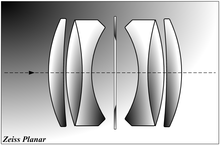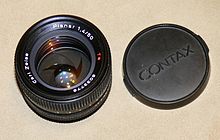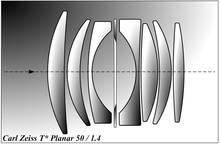Planar (lens)

Planar is a trademark registered in 1897 for an important variant of the Gaussian double lens . The planar has six lenses in its basic shape and was designed by Paul Rudolph for Carl Zeiss .
Basic design and development history
In its basic form, the planar has six lenses in four groups. Compared to the four-lens original of the Gaussian double lens , additional degrees of freedom are available for optimizing the imaging performance. A planar usually has two converging lenses in front, two diffusing lenses with the diaphragm in between and two converging lenses behind. The inner converging lenses are often cemented to the diverging lenses , which are comparatively strongly curved. The lens system as a whole is largely symmetrical.
A planar type lens was first presented and patented by Paul Rudolph in 1896 . In particular, the Planar succeeded in correcting not only spherical aberration and chromatic aberration , but also astigmatism . The planar still has a slight curvature of field , from which the name planar is derived.
Before the introduction of coated lens surfaces, objectives with several lens groups had to contend with a sometimes strong tendency to internal reflections . Between each pair of lens groups there are two glass-air junctions at which optical reflections can occur. If these reflections hit the photographic plate, the unwanted light leads to flat contrasts . Therefore at least four of the six lenses of the planar are combined into cemented groups. Despite the higher number of lenses, the reflection tendency of the planar is therefore only slightly greater than the reflection tendency of the original Gauss double objective with only four individual lenses. Hugo Meyer , on the other hand , succeeded in correcting the astigmatism with the four-lens aristostigmat while also significantly reducing the tendency to reflect. Meyer used strongly curved menisci , which have a very low tendency to reflect.
Further developments and variants
Due to its performance, partly derived from the original Gaussian double lens , the Planar became the starting point for a whole class of other lenses. These further developments deviate more and more from the "ideal" symmetrical structure.
Planar ƒ / 0.7 / 50 mm
The Planar ƒ / 0.7 with 50 mm focal length was originally designed by Zeiss for NASA in 1966 and is the fastest lens in the world. It was developed by the designer Erhard Glatzel (1925–2002) at Zeiss in Oberkochen (Germany). Glatzel received the Rudolf Diesel Medal in 1993 . In total, only ten copies were made in the 1960s, six of which went to NASA. Zeiss kept one for itself. NASA used this lens in the Apollo program in order to be able to photograph the dark areas of the moon that are not illuminated by the sun from orbit. Alternatively, the ƒ / 1.0 / 100 mm from Angénieux was available, but NASA was not satisfied with it.
The other three lenses were bought by the US director Stanley Kubrick in order to be able to shoot some special interior shots for the film Barry Lyndon . Without resorting to electrical lighting, the candlelight scenes were recorded on particularly sensitive film, which was only possible with this lens. In addition, the film material was underexposed by one f-stop. The depth of field is extremely small at the maximum aperture of ƒ / 0.7. At a distance of 2 m from the object, this area is only 7.95 cm in size. The actors therefore had to be very careful not to move too fast so that cameraman John Alcott did not lose focus. For his work on Barry Lyndon , John Alcott was awarded the 1976 Oscar for Best Cinematography.
The Planar ƒ / 0.7 has a relatively small image circle diameter mm 27, which half a small picture - negative can reasonably illuminate. Kubrick had the lens adapted to a Mitchell BNC 35 mm camera and shortened the focal length from 50 mm to 36 mm with a wide-angle attachment from Kollmorgen. One of Kubrick's three lenses was sold at auction in 2011 for 90,000 euros.
More planars
The seven-lens planar ƒ / 1.4 / 50 mm (see images) according to Glatzel from the 1970s, which is still known today, still sets standards for image quality. The medium format F-Planar ƒ / 2/110 mm for the Hasselblad focal plane shutter cameras can be described as another lens in the reference class . Many well-known camera manufacturers such as Hasselblad, Contax , Rollei and Linhof carry or have planar lenses in their lens range.
Further developments under other brand names
Examples of further developments under other brand names - sometimes from other manufacturers
- Xenon , 1925, developed by AW Tronnier for Schneider-Kreuznach ,
- Biotar , 1927, developed by Willi Merté for Carl Zeiss , as well as that
- Pancolar , a planar variant with 6–7 lenses.
Web links
Individual evidence
- ↑ Trademark register
- ↑ The fastest lens in the world: Zeiss ƒ / 0.7 / 50 mm ( Memento from March 9, 2009 in the Internet Archive )
- ↑ Guinness Book of Records 1997 category The Art: Photography . Hamburg 1996
- ↑ Two Special Lenses for "Barry Lyndon" by Ed DiGiulio (President, Cinema Products Corp.)
- ↑ Carl Zeiss AG - Das Planar ( Memento from November 14, 2013 in the Internet Archive ) (PDF; 1.3 MB), page 5



